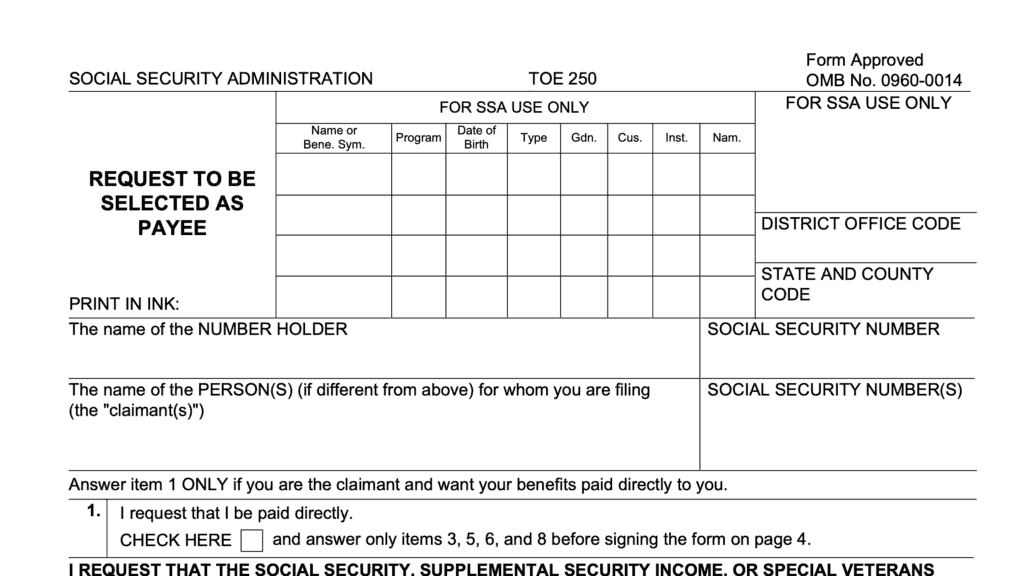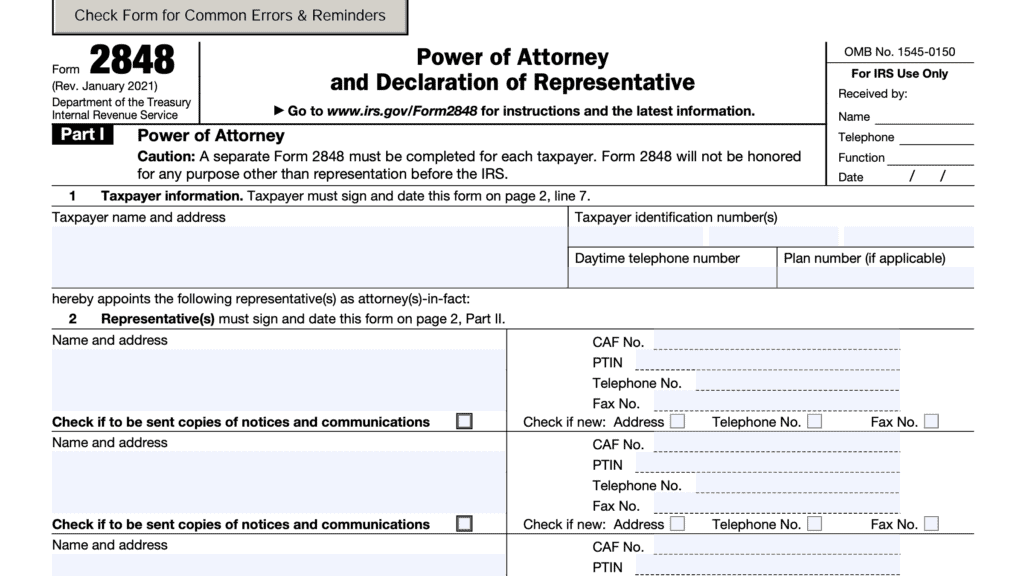Form SSA 1696 Instructions
If you’ve asked someone to help you claim Social Security benefits, you might be asked to complete a number of SSA forms. One of them is likely to be SSA 1696, Claimant’s Appointment of a Representative.
This article will walk you through everything you need to know as you complete Form SSA 1696. Let’s start with step-by-step instructions.
Contents
Table of contents
How do I complete Form SSA 1696?
We’ll walk through each step of filing Form SSA-1696. Most of the time, your appointed representative services office will help you with this. There are 8 sections:
- Section 1: Reason for Submission and Claimant’s Information
- Section 2: Representative’s Information
- Section 3: Claimant’s Principal Representative
- Section 4: Claim Type
- Section 5: Representative’s Status, Affiliations, and Certifications
- Section 6: Fee Arrangement
- Section 7: Other Claimants
- Section 8: Signatures
Section 1: Reason for Submission and Claimant’s Information
The first part of SSA 1696 contains the reason for submitting Form SSA 1696, as well as the claimant’s personal information.
Let’s take a closer look at the Reason for Submission field, first.
Reason for submission
Check the box that indicates the reason for submitting this form. You may appoint a new representative or update information that you previously submitted.
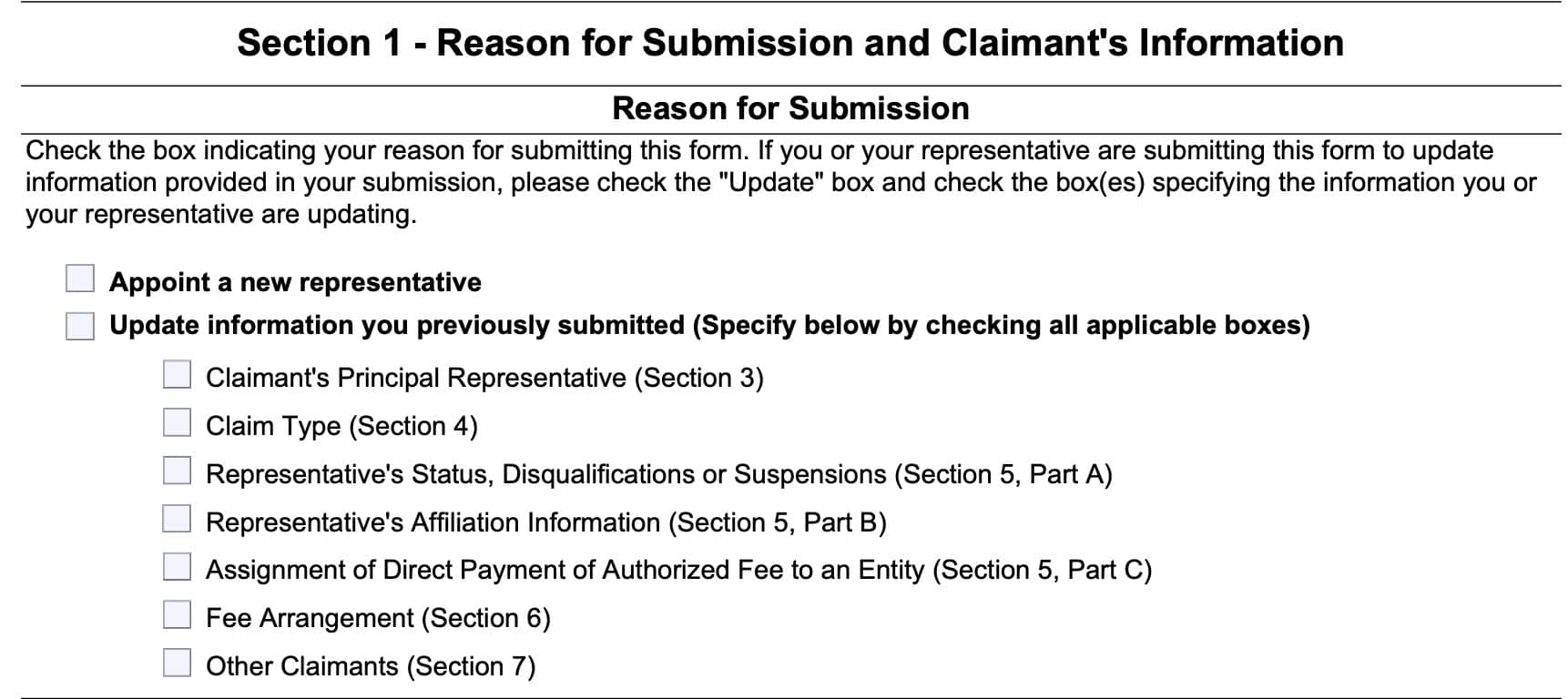
If you are updating information, then do the following:
- Select Update information you previously submitted
- Check the applicable fields that warrant updating
Claimant’s information
In this area, you’ll need to enter the following information:
- Claimant’s name
- First name, middle initial, and last name
- Claimant’s Social Security number
If applicable, enter the number holder’s information. This situation only applies if the claimant’s claim is based on another person’s work history or earnings information. This would apply in the case of spousal benefits, or for children claiming benefits based on a parent’s work history.
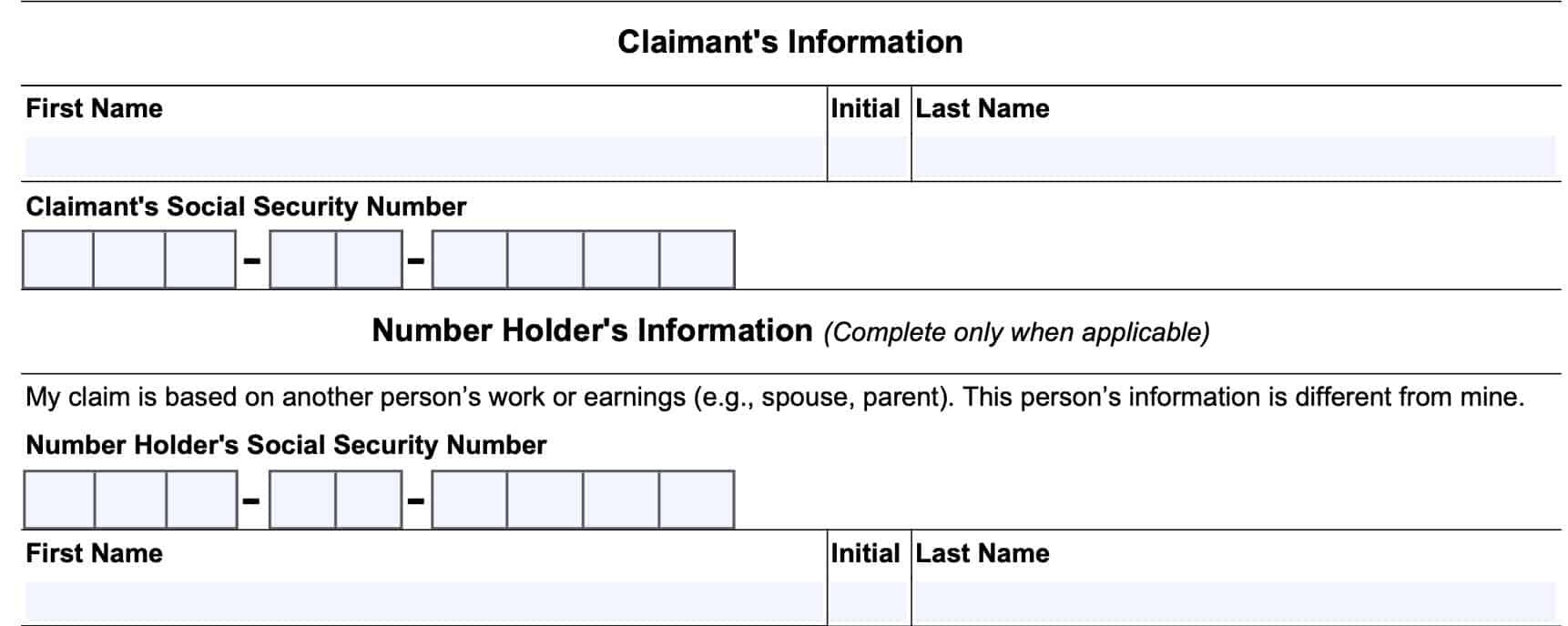
In this situation, enter the following:
- Number holder’s Social Security number
- Number holder’s first name, middle initial, and last name
From here, let’s move on to Section 2.
Section 2: Representative’s Information
The second section of the form contains the representative’s information.
Enter the following information in Section 2:
- Representative’s complete name
- Registered representative’s Rep ID number

If you do not have a Rep ID number
All representatives must register with the SSA and receive a Representative Identification, or Rep ID number. Your representative can learn more about how to register as a representative through the SSA website or by calling (800) 772-1213.
Representatives who wish to update their registration information must complete Form SSA-1699, Representative Registration.
Section 3: Claimant’s Principal Representative
At the top of this page, enter the following information:
- Claimant’s SSN
- Representative’s Rep ID
Only complete Section 3 if you checked the corresponding box under Reason for Submission.

The third section of the form contains the name of the applicant’s representative. According to the instructions, if you have multiple parties, then you would put down the name of the principal representative, or the primary point of contact in this section.
This is the person that the SSA will recognize as being authorized to work with them on your behalf.
Section 4: Claim Type
Only complete Section 4 if you checked the corresponding box under Reason for Submission.
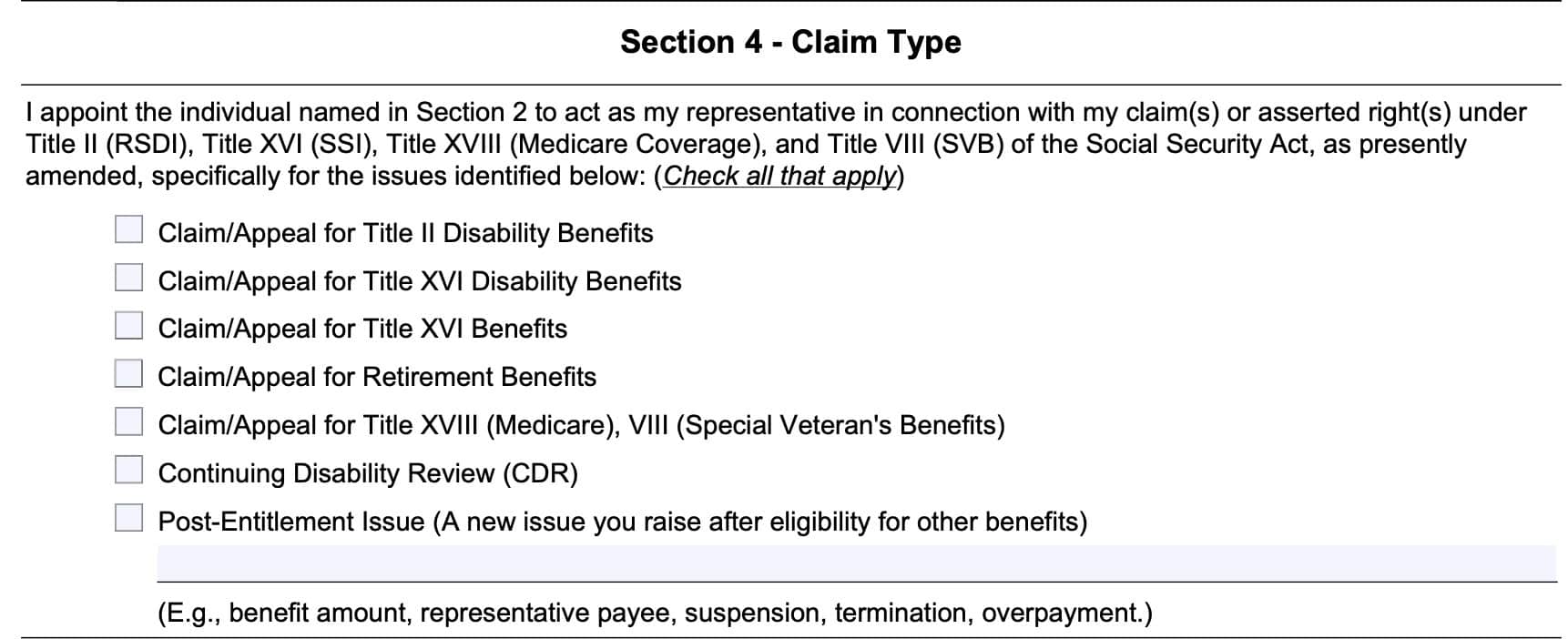
This section contains the type of claim that you are appointing your representative for. You may check one or more of the following types of claims:
- Claim or appeal for Title II disability benefits
- Claim or appeal for Title XVI disability benefits
- Claim or appeal for Title XVI benefits
- Claim or appeal for retirement benefits
- Claim or appeal for Medicare benefits (Title XVIII) or Special Veteran’s benefits (Title VIII)
- Continuing disability review (CDR)
- Post-Entitlement issue
- A new issue that comes up after you’re eligible for other benefits
Section 5: Representative’s Status, Affiliations, and Certifications
This is representatives section of the form, which your representative is responsible for completing. You should be familiar with each of the separate parts in this section. There are 4 parts to this section:
- Part A: Representative’s Status, Disqualifications, or Suspensions
- Part B: Representative’s Affiliation Information
- Part C: Assignment of Direct Payment of Authorized Fee to an Entity
- Part D: Representative’s Certifications
Let’s take a look at Part A.
Part A: Representative’s Status, Disqualifications, or Suspensions
Only complete Section 5, Part A if you checked the corresponding box under Reason for Submission.
Part A states what kind of representation this third party is declaring. Your representative could be one of the following:
- Attorney
- Non-attorney eligible for direct payment of fees
- Non-attorney not eligible for direct payment
Let’s take a closer look at each.
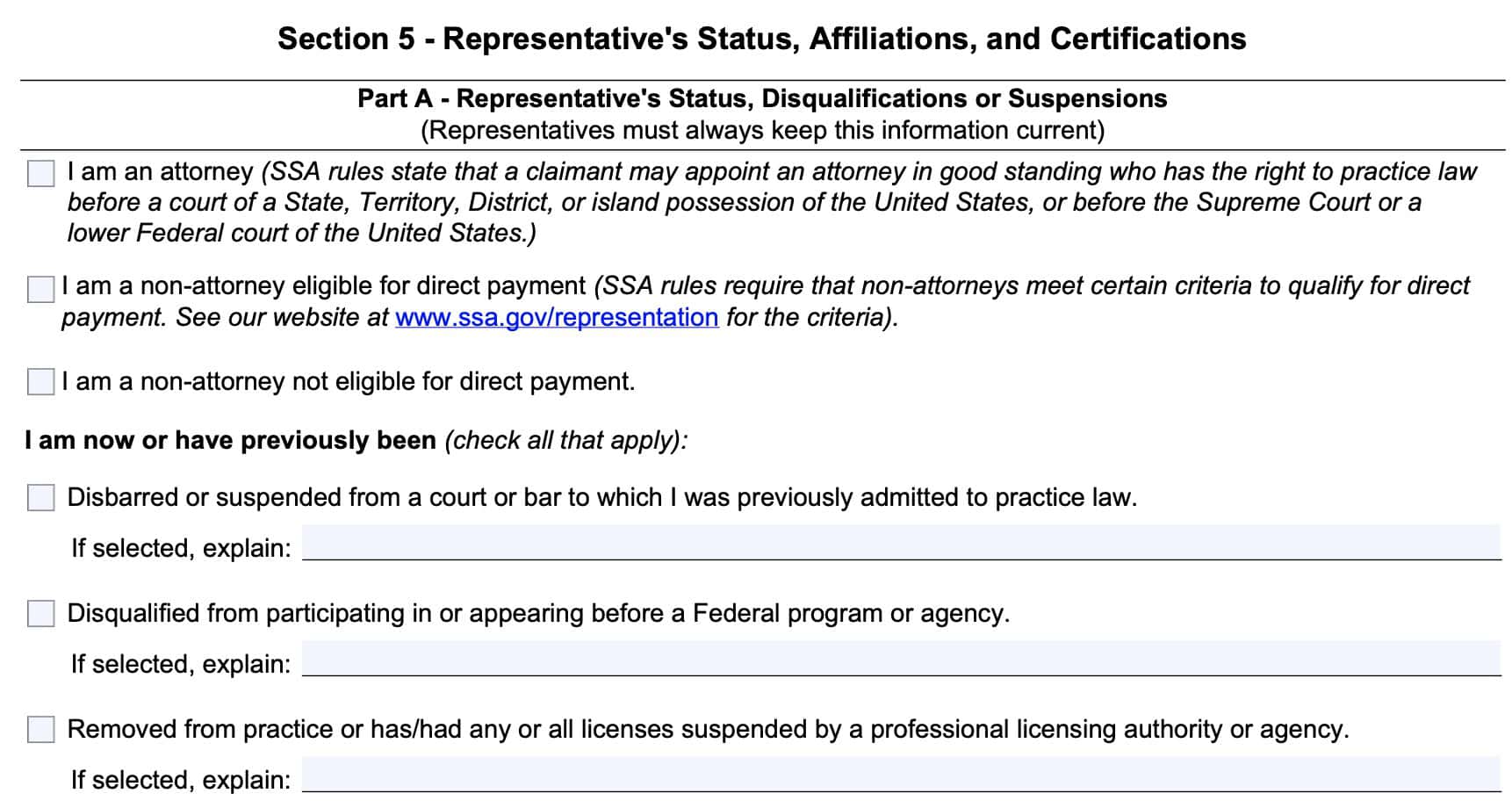
An attorney
Social Security law states that an attorney is considered to be someone in good standing and who has the right to practice law before any state or federal court, who is not disqualified or suspended, and who not otherwise prohibited from acting as a representative.
A non-attorney eligible for direct payment
Non-attorneys must meet certain criteria to qualify for direct fee payment. These criteria include:
- Possessing a bachelor’s degree
- Passing a written examination administered by the Social Security Administration
- Fulfilling a professional liability insurance requirement
- Completing a criminal background check
- Completing & maintaining continuing education courses
Non-attorney not eligible for direct payment
If a non-attorney does not meet the criteria stated above, then that person is not eligible for direct payment from the SSA.
Part A also forces the third party to disclose whether:
- They’ve been disbarred
- They’ve been suspended from practicing law or
- They’ve been disqualified from participating in a federal program or appearing before a federal agency.
Part B: Representative’s Affiliation Information
Only complete Section 5, Part B if you checked the corresponding box under Reason for Submission.

The affiliation information section is for an organization, such as a business entity, firm, or partnership, that may be affiliated with the appointed representative. To designate an affiliate for this claim, provide the entity’s name and employer identification number (EIN) in the space provided.
If there is no entity or other affiliation, enter No EIN.
Part C: Assignment of Direct Payment of Authorized Fee to an Entity
Only complete Section 5, Part C if you checked the corresponding box under Reason for Submission.
Check the Assignment box if you want to assign direct payment of your fee to the entity identified in Part B, above.

The representative should check the Rescission of prior assignment box if you want to rescind the prior assignment and receive payment directly without assigning the payment to that entity.
Part D: Representative’s certifications
The representative will initial the box in Part D to certify that the representative:
- Understands and agrees to comply with applicable policy and SSA rules
- Understands that he or she may be suspended or disqualified as a representative for failure to comply with applicable policy and rules
- Will not disclose information to unauthorized parties without the claimant’s written consent
- Is not currently suspended or disqualified from practicing before the Social Security Administration
- Is not prohibited from representing the claimant as a current or former officer or employee of the United States
- Accepts appointment as the representative for the claimant named in Section 1, in connection with rights and claims described in Section 4
- A copy of this signed SSA form will have the same force and effect as the original copy
- All information is true and correct to the best of his or her knowledge
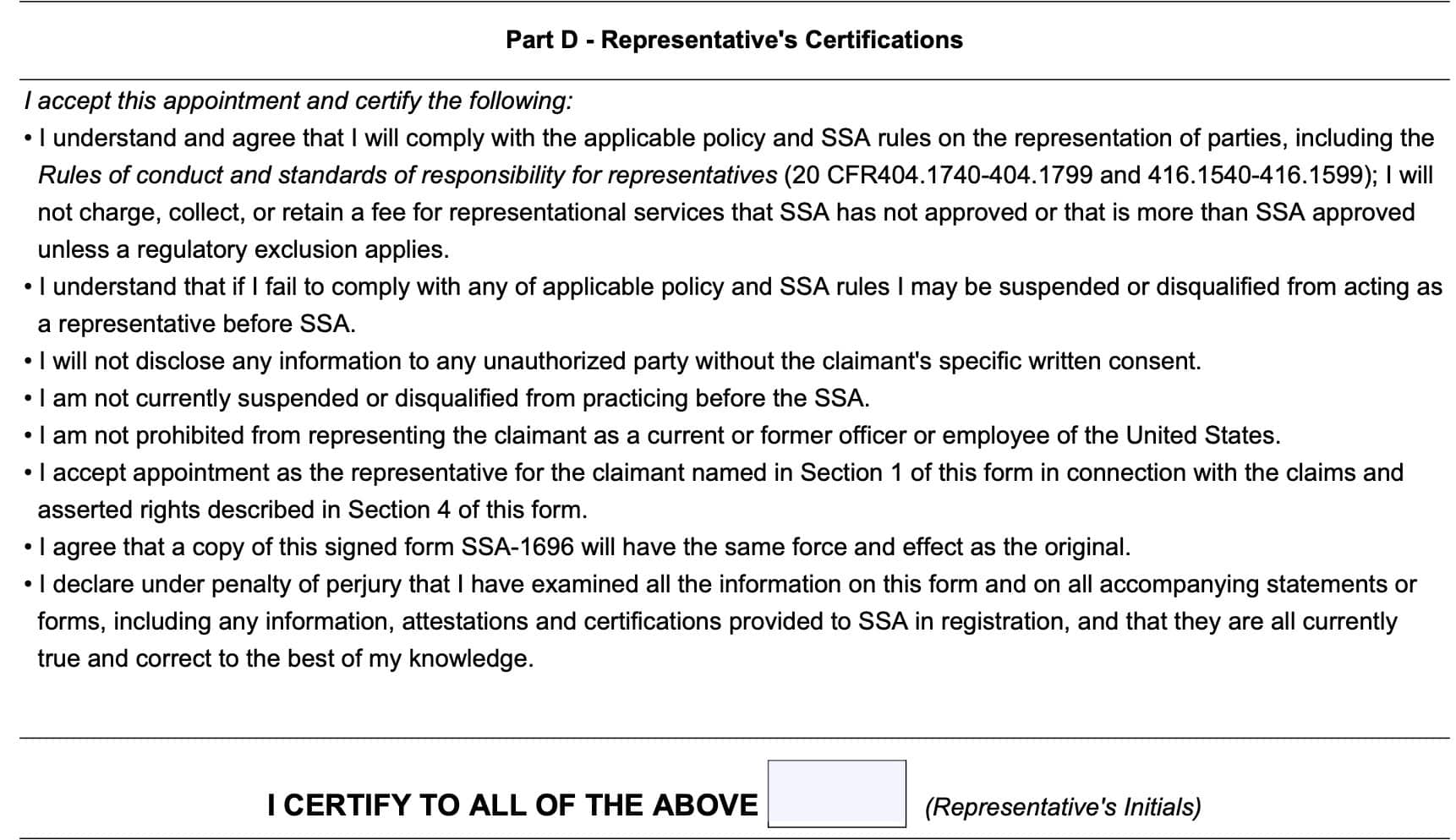
Section 6: Fee Arrangement
Only complete Section 6 if you checked the corresponding box under Reason for Submission.
Section 6 lists acceptable fee arrangements that the representative may pursue. Here are possible options your representative may request.
Request a fee and direct payment of this fee
According to the Social Security Administration, a representative may generally not accept a fee greater than either:
- $9,200
- 25% of the unpaid benefits due to the claimant, whichever is smaller
Direct payment means that the representative will be paid directly by the SSA from the claimant’s benefits.
For certain situations, the representative may request an increase in fee. However the representative must file a separate fee petition in writing. In all cases, SSA reserves the right to approve or disapprove any proposed fee, if the fee is not in line with written guidelines.
Request a fee but not direct payment
A representative may request a fee, but is either ineligible for direct payment, or does not want direct payment. The representative is responsible for collecting authorized fees. However, the SSA must allow the fee.
Waive the right to receive a fee from the claimant, auxiliary beneficiaries, or another individual
The representative may waive the right to collect a fee from the claimant or any associated individuals. This might happen if another entity, such as a non-profit organization or government agency is paying the costs.
Waive the right to a fee
This box would be selected if the representative is not requesting a fee.

Section 7: Other Claimants
Only complete Section 7 if you checked the corresponding box under Reason for Submission.
The field has SSN and name fields for up to 4 auxiliary claimants, such as children or spouse of the claimant, who do not have their own appointed representative.
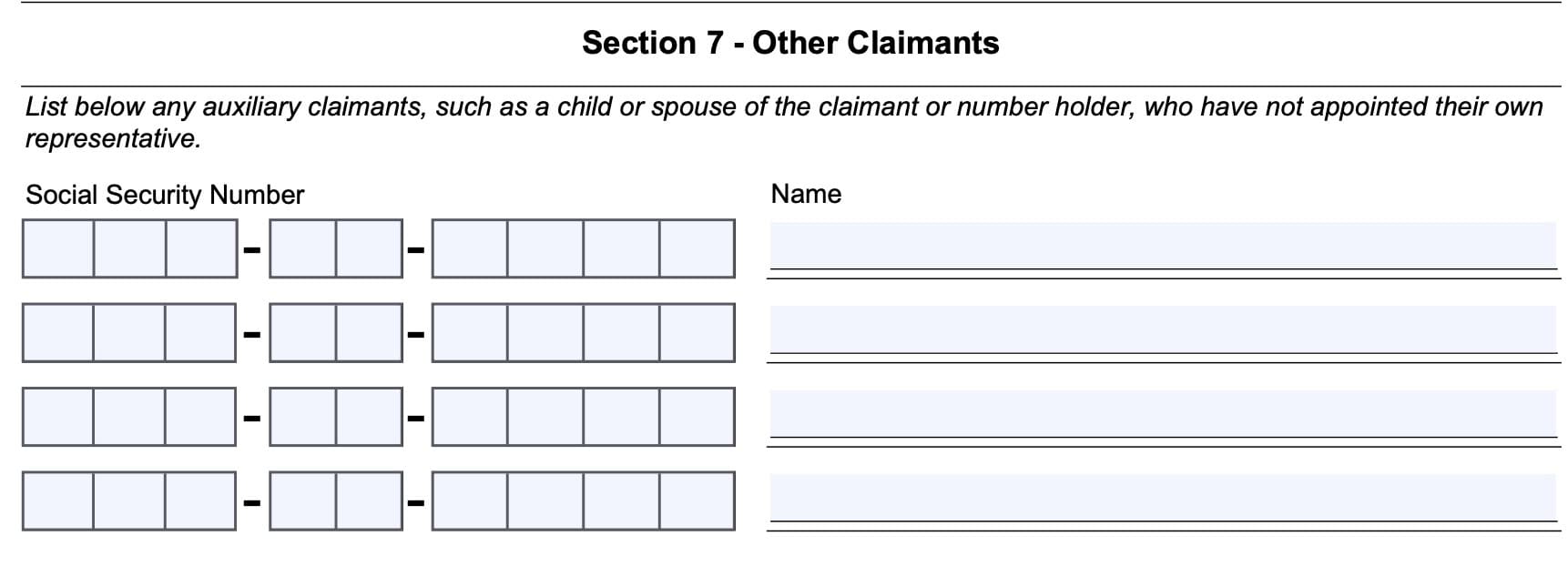
Section 8: Signatures
Both claimant and representative sign and date Section 8 of this form. Your representative’s office may ask that you provide an electronic signature instead of in writing.

Privacy Act Statement – Collection and Use of Personal Information
There is no required action in this section. But it’s good information to know, as there are certain federal laws that dictate what may (and what may not happen).
The Social Security Act authorizes the SSA to collect personal information, but the claimant doesn’t have to provide it. The SSA may share this information with other agencies, or in response to a congressional inquiry.
The Paperwork Reduction Act states that it should take about 30 minutes to complete this form.
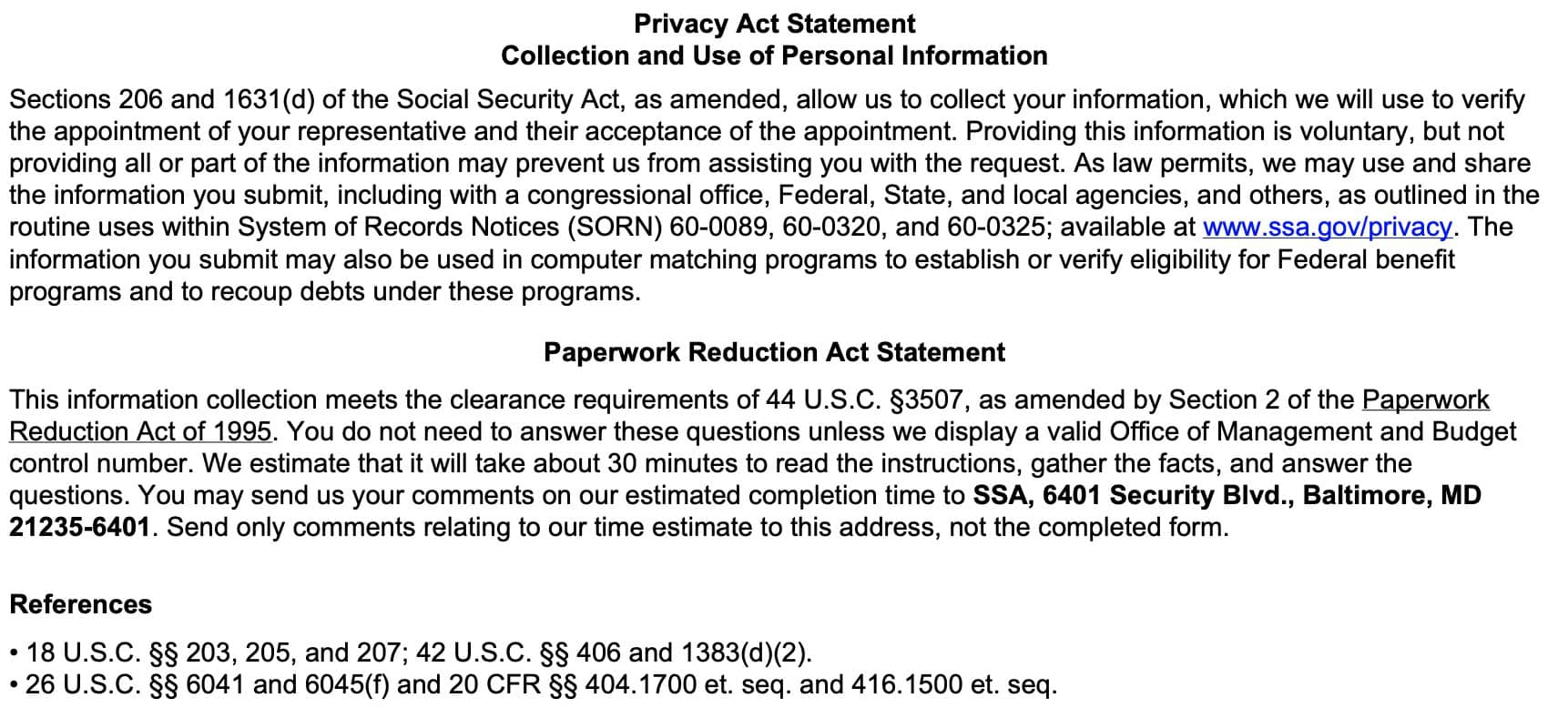
When should I use Form SSA 1696?
If you are filing for Social Security retirement benefits on your own behalf, you probably won’t need to use this form. However, if you’ve asked someone to help you, or if you’ve hired a third party to help you, then they will probably ask you to complete this form. Here are some of the situations in which you might need to complete SSA 1696:
- You’re filing for Social Security Disability benefits (SSDI) and you’ve asked someone to help you with the SSDI application process
- You’ve hired non-attorney representatives to help navigate the intricacies of the SSA as you apply for supplemental security income, or SSI payments
- You’ve hired a law firm to give you legal advice to file an appeal of a Social Security decision regarding your benefits
In any of these cases, having this form on file will enable the SSA to work directly with your appointed representative.
Video walkthrough
Watch this instructional video for step by step guidance on completing Form SSA-1696.
Frequently asked questions
Form SSA-1696, Appointment of Representative, form informs the Social Security Administration that as the claimant, you’ve appointed someone to help you with your claim to Social Security benefits. Having Form 1696 on file enables the Social Security Administration to share information with your appointed representative on your behalf.
If you are filing by yourself, you do not need Form SSA-1696. You only need SSA-1696 if someone is helping you complete the form and you want the Social Security Administration to work directly with that person on your behalf.
Yes. You may file Form SSA-1696 electronically through the SSA website.
Your representative should have clear guidance on what happens to this form once you’ve signed it. They will send the signed document to SSA for processing and approval, but should give you copies of the form as well.
Where can I find Form SSA-1696?
You can get copies of this form at your local Social Security Office, on the SSA website, or by clicking on the file below.

